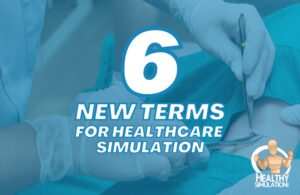ASPE GTA and MUTA Standards of Best Practice
The Association of Standardized Patient Educators (ASPE) is a global organization focused on human simulation via Standardized Patients, aka Simulated Patients. ASPE serves as a virtual community that connects to the field of medical simulation. The Association of Standardized Patient Educators (ASPE) published theASPE Standards of Best Practice (2017) to identify guidelines for individuals and programs working with standardized patients (SPs). This HealthySimulation.com article explores ASPE’s Standards of Best Practice (SOBP) for gynecological teaching assistants (GTA) and male urogenital teaching assistants (MUTA).
ASPE Standards of Best Practice
The ASPE SOBP identifies SPs as “a person trained to portray a patient in realistic and repeatable ways.” Standardized patients may portray a patient or be engaged in a purely instructional role. ASPE developed the SOBP in 2017. The ASPE Standards domains are safe work environment, case development, SP training, program management, and professional development.
Sponsored Content:
ASPE GTA / MUTA Standards of Best Practice
Gynecological Teaching Associates (GTAs) and Male Urogenital Teaching Associates (MUTAs), individuals who instruct learners to conduct breast, pelvic, rectal, urogenital, and prostate examinations, are two examples of the application of SP methodology. Gynecological Teaching Associates (GTAs) and Male Urogenital Teaching Associates (MUTAs) teach learners to perform accurate and respectful breast, speculum, bimanual vaginal, rectal, urogenital, and prostate examinations. As part of the instruction, the GTAs/MUTAs use their bodies to teach while providing real-time feedback. While GTAs/MUTAs fall under the broader umbrella of Standardized Patient methodology, the specificity of their role indicated the need for Standards of Best Practice tailored for their work. Using the original ASPE SOBP as the foundation for the new standards development, ASPE published The Association of Standardized Patient Educators (ASPE) Gynecological Teaching Associate (GTA) and Male Urogenital Teaching Associate (MUTA) Standards of Best Practice in Advances in Simulation.
Citation of the ASPE GTA / MUTA SOBP: Hopkins, Holly, et al. “The association of standardized patient educators (ASPE) gynecological teaching associate (GTA) and male urogenital teaching associate (MUTA) standards of best practice.” Advances in Simulation 6.1 (2021): 23.
ASPE GTA / MUTA Standards of Best Practice Development Process
Sponsored Content:
- Literature Review
- Subcommittee used a Delphi process to reach an international consensus
- Panelist Recruitment
- Survey using the ASPE SOBP framework, panelists completed three iterative rounds of surveys on relevant concepts
- Rate on a 5-point scale and provide rationals for each concept
- Brainstorming
- Pre-testing survey workshop 2018 ASPE Conference
- Consolidation of response by subcommittee
- Consensus with descriptive statistics using SPSS
- Presented the ASPE GTA / MUTA SOBP at the ASPE Annual Conference 2019
View the LEARN CE/CME Platform Webinar Getting Started with High Fidelity to learn more!
Domains of ASPE GTA / MUTA SOBP
There were four domains for the SOBP. Each of the domains has principles and practice concepts. Some practice concepts within these four domains have been omitted as reflected components related to SP simulation as opposed to GTA/MUTA instructional sessions. This indicates that the consensus building process was effective. Only one panelist was lost to attrition once the survey process began, indicating that the surveys were not too complex or time consuming.
Domain 1: Safe Work Environment: Physical and psychological safety is critical in all
working and learning environments, but it is especially critical when instructing learners to conduct sensitive examinations as GTAs/MUTAs do. This domain has three principles: safe work practice (15 practice concepts), confidentiality (four practice concepts), and respect (three practice concepts).
Domain 2: Instructional Session Development: While the ASPE SOBP Domain 2 focused on Case Development, GTAs/MUTAs primarily participate in instructional sessions, as opposed to portraying cases, indicating the need for a shift in terminology. This domain has two principles: preparation (five practice concepts) and instructional session components (8 practice concepts).
Domain 3: GTA / MUTA Training: Training may be accomplished in a variety of ways, depending on the program goals. The training curriculum should be designed in a manner consistent with the learning theories and norms of the broader SP program or simulation center, as appropriate. The objectives of the instructional session will determine the extent of the training necessary regarding knowledge of physical examination techniques and the effective provision of feedback to facilitate learner confidence and competence. This domain has four principles: preparation for training (5 practice concepts), training for instructional session (12 practice concepts), training for feedback (7 practice concepts), and reflection on the training process (one practice concept).
Domain 4: Program Management: Many GTA/MUTA programs exist within broader SP and/
or simulation programs. Regardless of their institutional affiliation or location, the broad program should follow standard business processes and procedures. This includes “creating financial management, business, and strategic plans” for the broad organization and (as applicable) specific programs. The purpose for the GTA/MUTA instructional session should be determined, and should be consistent throughout. This domain has six principles: purpose (three practice concepts), expertise (five practice concepts), policies and procedures (10 practice concepts), records management (two practice concepts), team management (5 practice concepts), and quality management (four practice concepts).
More About ASPE and Standardized Patient Methodology
As the international organization of simulation educators, the Association of Standardized Patient Educators is dedicated to promoting best practices in the application of SP methodology for education, assessment, and research. ASPE’s purpose includes fostering the dissemination of research and scholarship in the field of SP methodology and working to advance the professional knowledge and skills of its members.
In transforming professional performance through the power of human interaction, ASPE members serve as a great resource and are always ready to help others with SP training, curriculum and program development, and center creation. Encouraged to share their expertise and experience regarding anything related to SP methodology, members all around the world provide strength and insight to the association.
The terms standardized patient and simulated patient (SP) are often used interchangeably and refer to a person trained to portray a patient in realistic and repeatable ways. SPs interact with learners in experiential education and assessment contexts. Learners, depending on the context, are variously described as students, trainees, participants, examinees, or candidates. SPs can also provide feedback on learner performance from the perspective of the person they portray, which is unique to working with SPs. SP-based education has grown in size and scope of practice to include many different roles. For this reason, the term simulated participant is being used as a more inclusive term to refer to all human role players in any simulation context.
Overall, the context in which SPs work determines the degree of repeatability or standardization (consistency and accuracy) of their behavior, both within an individual SP’s performance and between SPs portraying the same role. This behavior can be seen as part of a continuum, according to ASPE. On one end of the continuum, in high stakes assessment, SPs may be trained to behave in a highly repeatable or standardized manner in order to give each learner a fair and equal chance and are often referred to as standardized patients.
In this context, SPs are individuals whose behavior has been standardized. In more formal educational settings, where standardization may not play an important part of the session design, carefully trained SPs are able to respond with more authenticity and flexibility to the needs of individual learners and are referred to as simulated patients.
ASPE GTA / MUTA Standards of Best Practice Latest News

Healthcare Simulation Research June 2024

Global Medical Simulation Industry News Update June 2024

2024 ASPE Annual Conference

Global Medical Simulation News Update April 2024

Enhancing Healthcare Simulation-Based Education with High-Fidelity Standardized Patients

Women in Leadership Virtual Event Empowers Clinical Simulation Community

Uses of Simulation Educator Needs Assessment Tool (SENAT)

How Healthcare Simulation Can Help Mitigate Workplace Violence

How To Implement a Volunteer Standardized Participant Program

Research Update: Clinical Simulation in Nursing | December 2022
Sponsored Content:
















